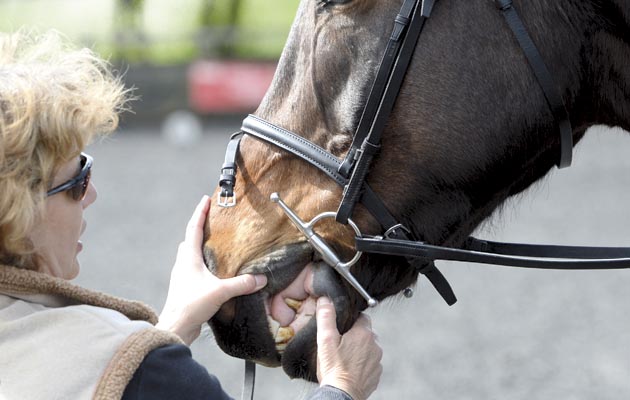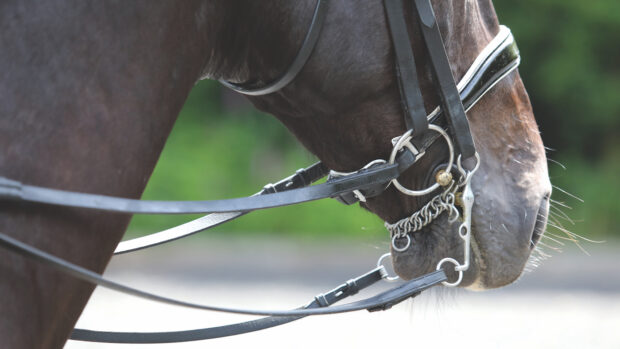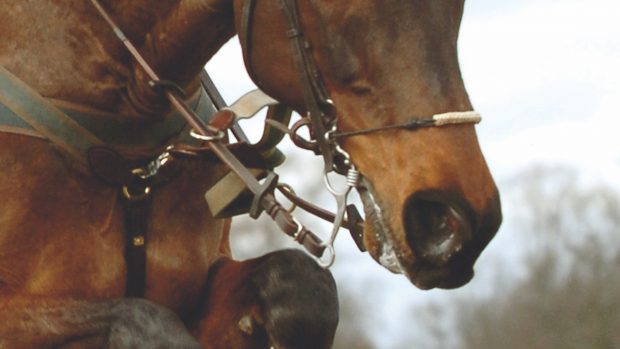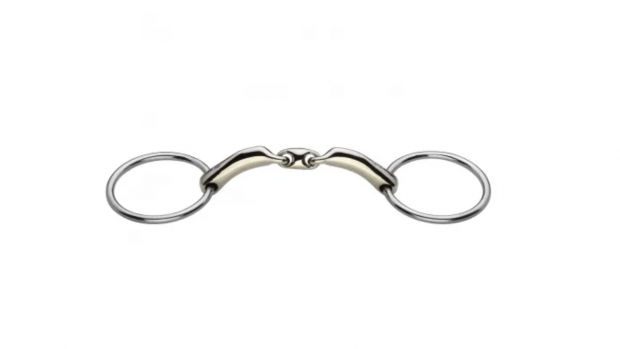What is a Cheltenham gag?
The Cheltenham gag typically has eggbutt bit rings, which help reduce any risk of the horse’s lips being pinched, with two holes in each ring; one at the top and one directly underneath. This bit is used with gag cheekpieces, which thread through the holes, and attach to the bridle’s headpiece. They are normally made out of rolled leather or cord – the leather cheeks look smarter, but they don’t slide through the cheeks as quickly as the cord ones do, which means the cord gag cheeks have a faster and clearer aid.

Shires Cheltenham Gag at viovet.co.uk
This bit is available in 4½–6in. It’s made of stainless steel, which is durable, easy to clean, tasteless and does not rust.

Sprenger Rope Gag Cheeks at viovet.co.uk
Made from leather and double nylon rope, these cheeks slide through the bit rings more quickly for a more precise aid.

Collegiate Gag Cheek Pieces at viovet.co.uk
Available in black and brown, these cheek pieces fits all Cheltenham and running gag type bits and come with a screw fastening for easy use.
The mouthpiece of this bit can be made from a variety of materials including a range of metals, rubber and more, while the design of the mouthpiece can vary to cater for a wide range of mouth shapes and types of horse.
Bitting expert, BETA field officer and lorinery consultant Tricia Nassau-Williams explains: “With so many lever bits on the market that are also described as gags, it is best for the sake of clarity, to refer to Cheltenham gag bits as running gags. This describes their action as the bit runs upwards on the bridle’s specially adapted rounded leather or nylon cord cheek pieces. These cheek pieces pass through the bit’s specially adapted sides, with their lower section concluding in rings to which a set of reins are attached. The cheek’s top end buckles onto the bridle’s headpiece.”
This bit is recommended for use with two reins, with one set attached to the end of the cheek straps and one directly to the bit rings. The Cheltenham gag is most commonly seen in eventing and showjumping, when increased control is required, and should be used by experienced riders only.
How does a Cheltenham gag work?
The Cheltenham gag typically has eggbutt rings, which help prevent the bit from moving around too much in the mouth and can encourage the horse to stretch forward into the contact. It should be used with two reins. The first rein should be attached to the bit ring and then the second should be attached to the rings on the gag cheeks.
The rein on the bit ring will act as a normal eggbutt snaffle would. The second rein on the gag cheek has a running effect, which raises the bit in the horse’s mouth and encourages the horse to lift up off the forehand if they become heavy in the hand. The rider should primarily use the snaffle rein for communication, with the gag rein only being used momentarily when needed to steady or rebalance the horse.
Tricia says: “The effect of the action of a Cheltenham gag is to raise the bit in the mouth and so the horse’s head and neck. Pressure through the bridle will be applied over the head and poll, in addition to the strong upwards action on the tongue, bars and corners of the mouth. With this additional pressure to the poll area of the head, a wide padded headpiece is beneficial for greater comfort.
“It is also important to note the leather bridle cheeks, as they are attached onto the headpiece, must be of an adequate width for the pressure being placed upon them. Three-quarters of an inch wide is best, and they must be no narrower than 5/8”. That said, you do see bridles with ½” wide bridle cheeks, but that is a lot of pressure to place on such a small strap of leather. This is a safety issue to prevent breakages. For fear of this happening, some riders fit a running gag with an additional bradoon sliphead for extra security. Care will also need to be taken not to put uneven pressure across the horse’s bridle path area.”
Which type of horse would this bit suit?
This bit is used mostly on horses that lean on the bit and become strong during faster work. This bit would be useful if your horse tends to gallops on the forehand or is heavy on the front end. It can be used to help retrain the horse to carry itself, rather than relying on the rider to support its balance.
Tricia says that Cheltenham gag bits are useful for “bold horses, when in fast work, who tend to lean or go with their head down below the line of control from the rider’s hand to the bit. With its strong lifting action, a running gag can be effective. It is not recommended for use in everyday riding, but it can be a useful bit when additional control is needed in the hands of skilled, educated riders.
“Bitting horses is very much about selecting the most appropriate mouthpiece for your individual horse’s conformation and then selecting the category (family) of bitting. So a horse may have the same mouthpiece design with a snaffle/bradoon or running gag or pelham or lever bit.
“The correct mouthpiece selection is critical to happy bitting but it does not define the category (family) of bitting that the bit belongs to. This is defined by the function and mechanics of the bit’s side sections.”
Where to buy this bit for your horse?

Shires Cheltenham Gag
Sizes: 4½–6in | RRP: £23.99 |
This bit is designed to be used with gag cheeks, which you’ll need to buy separately – and two sets of reins are recommended to help stop the horse leaning on the bit or for when more control is needed.
Mouthpiece thickness: 14mm, cheek height: 75mm. Being stainless steel, it’s durable, easy to clean, tasteless and does not rust.
In the UK? View now at amazon.co.uk, viovet.co.uk, gsequestrian.co.uk, equus.co.uk or naylors.com

OTTE Cheltenham Gag With Copper Roller and Inlay at amazon.co.uk
This Cheltenham gag has a mouthpiece with a roller and copper elements.

OTTE Cheltenham Gag With Double Joint at amazon.co.uk
This bit is made from German silver, which encourages the horse to salivate and promotes bit acceptance.

Collegiate Gag Cheek Pieces at viovet.co.uk
Available in black and brown, these cheek pieces fits all Cheltenham and running gag type bits and come with a screw fastening for easy use.

Sprenger Rope Gag Cheeks at viovet.co.uk
Made from leather and double nylon rope, these cheeks slide through the bit rings more quickly for a more precise aid.
You may also be interested in…

The Waterford bit: how does it work and what type of horse does it suit?

Choosing the right bit: would a Dutch gag suit my horse?

5 top tips to help you choose the perfect bit for your horse

Does your bit fit? How to measure your horse’s mouth size

Subscribe to Horse & Hound magazine today – and enjoy unlimited website access all year round
Horse & Hound magazine, out every Thursday, is packed with all the latest news and reports, as well as interviews, specials, nostalgia, vet and training advice. Find how you can enjoy the magazine delivered to your door every week, plus options to upgrade your subscription to access our online service that brings you breaking news and reports as well as other benefits.





